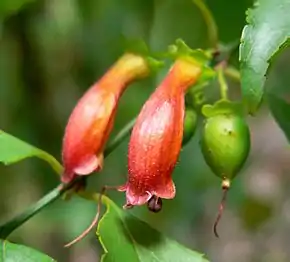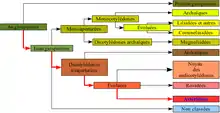Stilbaceae
La famille des Stilbaceae ou Stilbacées regroupe des plantes dicotylédones. En classification phylogénétique APG III (2009)[1] c'est une petite famille qui comprend quelques douzaines d'espèces.

Voir le texte pour plus d'information.

| Clade | Angiospermes |
|---|---|
| Clade | Dicotylédones vraies |
| Clade | Astéridées |
| Clade | Lamiidées |
| Ordre | Lamiales |
Ce sont des buissons à feuilles entières très serrées, originaires des régions tropicales ou subtropicales d’Afrique du Sud.
Étymologie
Le nom vient du genre type Stilbe, du grec Στίλβη / Stilbe, brillance[2].
Dans la mythologie grecque, Stilbé était une nymphe et une des filles de Penée dieu du fleuve et de la naïade Créuse. Elle était la mère de Centauros, ancêtre des centaures
Classification
Cette famille n'existe pas en classification classique de Cronquist (1981)[3] qui assigne Nuxia à la famille des Buddlejaceae et les autres genres à la famille des Verbenaceae.
Liste des genres
Selon World Checklist of Selected Plant Families (WCSP) (12 nov. 2015)[4] :
- Campylostachys Kunth (1831)
- Euthystachys A.DC. (1848)
- Kogelbergia Rourke (2000)
- Nuxia Comm. ex Lam. (1791)
- Retzia Thunb. (1776)
- Stilbe Berg. (1767)
- Thesmophora Rourke (1993)
Selon Angiosperm Phylogeny Website (12 nov. 2015)[5] :
- Anastrabe Bentham
- Bowkeria Harvey
- Brookea Bentham (does this really go here?)
- Charadrophila Marloth
- Ixianthes Bentham
- Halleria L.
- Nuxia Lamarck
- Stilbe Bergius
- Thesmophora Rourke
Selon NCBI (12 nov. 2015)[6] :
- Anastrabe
- Bowkeria
- Campylostachys
- Charadrophila
- Euthystachys
- Halleria
- Ixianthes
- Kogelbergia
- Nuxia
- Retzia
- Stilbe
Selon DELTA Angio (12 nov. 2015)[7] :
- Campylostachys
- Eurylobium
- Euthystachys
- Stilbe
- Xeroplana
Liste des espèces
Selon World Checklist of Selected Plant Families (WCSP) (8 Jul 2010)[8] :
- genre Campylostachys Kunth (1831)
- Campylostachys cernua (L.f.) Kunth (1831)
- genre Euthystachys A.DC. (1848)
- Euthystachys abbreviata (E.Mey.) A.DC. (1848)
- genre Kogelbergia Rourke (2000)
- Kogelbergia phylicoides (A.DC.) Rourke (2000)
- Kogelbergia verticillata (Eckl. & Zeyh.) Rourke (2000)
- genre Nuxia Comm. ex Lam. (1791)
- Nuxia allorgeorum Jovet (1947)
- Nuxia ambrensis Jovet (1947)
- Nuxia capitata Baker (1882)
- Nuxia congesta R.Br. ex Fresen. (1838)
- Nuxia coriacea Soler. (1893)
- Nuxia floribunda Benth. (1836)
- Nuxia glomerulata (C.A.Sm.) Verd. (1958)
- Nuxia gracilis Engl. (1889)
- Nuxia involucrata Aug.DC. (1901)
- Nuxia isaloensis Jovet (1947)
- Nuxia oppositifolia (Hochst.) Benth. (1846)
- Nuxia pachyphylla Baker, J. Linn. Soc. (1887)
- Nuxia pseudodentata Gilg (1895)
- Nuxia sphaerocephala (Baker) Baker, J. Linn. Soc. (1887)
- Nuxia verticillata Lam. (1792)
- genre Retzia Thunb. (1776)
- Retzia capensis Thunb. (1776)
- genre Stilbe Berg. (1767)
- Stilbe albiflora E.Mey. (1838)
- Stilbe ericoides (L.) L. (1771)
- Stilbe gymnopharyngia (Rourke) Rourke (2000)
- Stilbe overbergensis Rourke (2000)
- Stilbe rupestris Compton (1944)
- Stilbe serrulata Hochst. (1842)
- Stilbe vestita Berg. (1767)
- genre Thesmophora Rourke (1993)
- Thesmophora scopulosa Rourke (1993)
- genre Anastrabe
- Anastrabe integerrima
- genre Bowkeria
- Bowkeria cymosa
- Bowkeria verticillata
- genre Campylostachys
- Campylostachys cernua
- genre Charadrophila
- Charadrophila capensis
- genre Euthystachys
- Euthystachys abbreviata
- genre Halleria
- Halleria elliptica
- Halleria lucida
- Halleria ovata
- Halleria tetragona
- genre Ixianthes
- Ixianthes retzioides
- genre Kogelbergia
- Kogelbergia verticillata
- genre Nuxia
- Nuxia congesta
- Nuxia floribunda
- Nuxia oppositifolia
- Nuxia sp. Hedberg 4731
- genre Retzia
- Retzia capensis
- genre Stilbe
- Stilbe albiflora
- Stilbe ericoides
- Stilbe overbergensis
- Stilbe rupestris
- Stilbe vestita
Notes et références
- (en) Angiosperm Phylogeny Group, « An update of the Angiosperm Phylogeny Group classification for the orders and families of flowering plants: APG III », Botanical Journal of the Linnean Society, Wiley-Blackwell, Linnean Society of London et OUP, vol. 161, no 2, , p. 105–121 (ISSN 0024-4074 et 1095-8339, DOI 10.1111/J.1095-8339.2009.00996.X)
- (en) Maarten J M Christenhusz, Michael F Fay et Mark W. Chase, Plants of the World : An Illustrated Encyclopedia of Vascular Plants, Chicago, The University of Chicago Press, , 792 p. (ISBN 978-0-2265-2292-0), p. 559
- (en) Arthur Cronquist, An Integrated System of Classification of Flowering Plants, New York, Columbia University Press, (ISBN 0-231-03880-1, OCLC 1136076363, lire en ligne)
- WCSP. World Checklist of Selected Plant Families. Facilitated by the Royal Botanic Gardens, Kew. Published on the Internet ; http://wcsp.science.kew.org/, consulté le 12 nov. 2015
- Stevens, P. F. (2001 onwards). Angiosperm Phylogeny Website. Version 14, July 2017 [and more or less continuously updated since]." will do. http://www.mobot.org/MOBOT/research/APweb/, consulté le 12 nov. 2015
- NCBI, consulté le 12 nov. 2015
- DELTA Angio, consulté le 12 nov. 2015
- WCSP. World Checklist of Selected Plant Families. Facilitated by the Royal Botanic Gardens, Kew. Published on the Internet ; http://wcsp.science.kew.org/, consulté le 8 Jul 2010
- NCBI, consulté le 8 Jul 2010
Liens externes
- (en) Référence Madagascar Catalogue : Stilbaceae
- (en) Référence Kew Garden World Checklist : Stilbaceae
- (en) Référence Angiosperm Phylogeny Website : Stilbaceae ()
- (en) Référence Jardin botanique du Missouri : Stilbaceae (images de Madagascar)
- (en) Référence DELTA Angio : Stilbaceae Kunth
- Voir aussi Verbenaceae
- (en) Référence Paleobiology Database : Stilbaceae Kunth
- (en) Référence NCBI : Stilbaceae (taxons inclus)
- (en) Référence GRIN : famille Stilbaceae Kunth (+liste des genres contenant des synonymes)
- Portail de la botanique